Plot
The film begins on December 8, 1941 with the Japanese attacking the Philippines. Dave McVey Jr., the son of a rich American businessman with extensive holdings in the Philippines, is attacked by murderous bandits. He is rescued by Careo, a Filipino patriot who has put together a group of anti-Japanese Filipino guerrillas. Carero hides Dave with an elderly Filipino and his granddaughter, who teach Dave Tagalog.
Careo returns again to tell Dave that his father has left the Philippines, but Dave is joined by a fellow American, Joe Trent, a rough merchant sailor who was third mate on a cargo ship that was sunk by the Japanese. Joe's ship was part of a merchant line owned by Dave's father. Joe figures that Dave's father will reward him for keeping his son safe. Joe gets drunk and rapes the teenage granddaughter. When the girl starts screaming, Dave has no choice but to flee with Joe.
They meet a band of armed Filipinos led by Atong and the English-speaking woman Sisa. The quick-thinking Joe tells the band that if they bring them to Colonel Ryker, an American officer in charge of a guerrilla unit, Ryker will reward them. Ryker tells Dave that the Japanese would probably give him a comfortable existence and might repatriate him to the United States because of his father's extensive business dealings with Japan. Dave replies that his father's connections to Japan were from before the war and he would rather fight with the guerrillas. The group joins Ryker's unit in fighting the Japanese.
Joe is promoted to lieutenant and is to accompany a Filipino captain on a raid against a Japanese-held sugar refinery and railway. Joe brings Dave, Atong, Sisa and a group of their original band on the mission. After the captain is killed, Atong kills one of his own men over the captain's pistol. Joe makes Atong give the pistol to Dave. Not wishing to complete their mission, Joe sends Dave and Sisa into a village to ask the locals for food. As they are negotiating, Joe's band massacres the villagers to steal their rice, with Joe shooting Atong during the raid. Sisa quickly switches her loyalties to Joe.
Production
Producer Joe Steinberg had a wealthy brother named Harry Stonehill in the Philippines who assisted with the financing of the film. He hired his friends Irving Lerner to direct and Bernard Gordon to write the screenplay. Gordon saw the opportunity to use the screenplay as a comment on American attitudes toward Third World people and attitudes about masculinity, explaining the film's working title of To Be a Man. [2] In the film, Dave asks Joe if raping his host's granddaughter made him feel like a man. Joe responds that fighting when necessary and having a woman when possible meant feeling like a man. Joe also initiates Dave into manhood by using his winnings in a poker game to give Dave a night with a prostitute. In Dave's first battle, he captures a panicked Japanese soldier, and Joe grabs Dave's hands and holds his rifle with bayonet, which he thrusts into the prisoner.
The film was shot in the Philippines. [3] In early 1962, prior to filming, the visas were held up as the script was deemed offensive to Filipinos with Vice President Emmanuel Pelaez stating that the script "makes them the object of condescension and contempt" and was an "insult to the Filipino people". [4] [5]
Rita Moreno's scenes were shot around her travel to Hollywood to accept the Academy Award for Best Supporting Actress for West Side Story . A Filipino designed her dress for the awards ceremony, which Edith Head voted the most original of the night. The designer returned to the Philippines the next day. [6]
Moreno's planned nude bathing scene in the film attracted a great deal of publicity. [7] She eventually filmed the scene wearing a dress. [8]
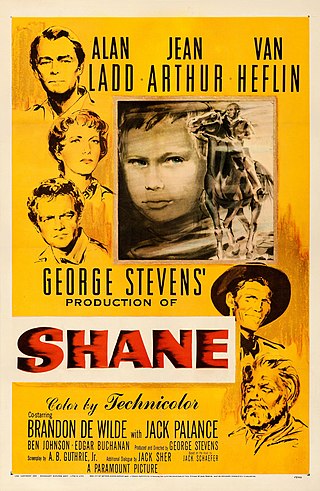
Shane is a 1953 American Technicolor Western film starring Alan Ladd, Jean Arthur, and Van Heflin. Released by Paramount Pictures, the film is noted for its landscape cinematography, editing, performances, and contributions to the genre. The picture was produced and directed by George Stevens from a screenplay by A. B. Guthrie Jr., based on the 1949 novel of the same name by Jack Schaefer. Its Oscar-winning cinematography was by Loyal Griggs.

Ilocos Sur, officially the Province of Ilocos Sur, is a province in the Philippines located in the Ilocos Region in Luzon. Located on the mouth of the Mestizo River is the capital of Vigan. Ilocos Sur is bordered by Ilocos Norte and Abra to the north, Mountain Province to the east, La Union and Benguet to the south and the South China Sea to the west.

Rita Moreno is a Puerto Rican actress, dancer, and singer. She is noted for her work on stage and screen in a career spanning over seven decades. Moreno is one of the last remaining stars from the Golden Age of Hollywood. Among her numerous accolades, she is one of a few performers to have been awarded an Emmy, a Grammy, an Oscar, and a Tony (EGOT) and the Triple Crown of Acting, with individual competitive Academy, Emmy, and Tony awards. Additional accolades include the Presidential Medal of Freedom in 2004, the National Medal of Arts in 2009, the Screen Actors Guild Life Achievement Award in 2013, the Kennedy Center Honor in 2015, and a Peabody Award in 2019.
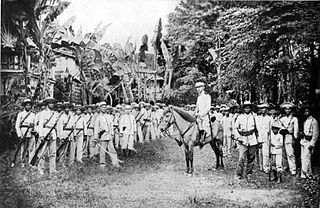
The Battle of Tirad Pass, sometimes referred to as the "Philippine Thermopylae", was a battle in the Philippine–American War fought on December 2, 1899, in northern Luzon in the Philippines, in which a 60-man Filipino rear guard commanded by Brigadier General Gregorio del Pilar succumbed to more than 500 Americans, mostly of the 33rd Volunteer Infantry Regiment under Major Peyton C. March, while delaying the American advance to ensure that President Emilio Aguinaldo and his troops escaped.

Emmett Evan "Van" Heflin Jr. was an American theatre, radio, and film actor. He played mostly character parts over the course of his film career, but during the 1940s had a string of roles as a leading man. Heflin won the Academy Award for Best Supporting Actor for his performance in Johnny Eager (1942). He also had memorable roles in Westerns such as Shane (1953), 3:10 to Yuma (1957), and Gunman's Walk (1958).

Cainta, officially the Municipality of Cainta, is a 1st class urban municipality in the province of Rizal, Philippines. According to the 2020 census, it has a population of 376,933 people.
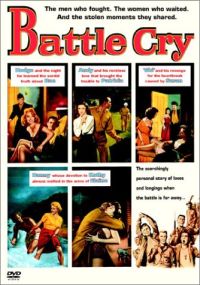
Battle Cry is a 1955 Warnercolor film, starring Van Heflin, Aldo Ray, James Whitmore, Tab Hunter, Nancy Olson, Anne Francis, Dorothy Malone, Raymond Massey, and Mona Freeman in CinemaScope. The film is based on the 1953 novel by former Marine Leon Uris, who also wrote the screenplay, and was produced and directed by Raoul Walsh. The film was shot at Camp Pendleton, California, and featured a large amount of cooperation from the United States Marine Corps.

Lamberto Vera Avellana was a prominent Filipino film and stage director. Despite considerable budgetary limitations that hampered the post-war Filipino film industry, Avellana's films such as Anak Dalita and Badjao attained international acclaim. In 1976, Avellana was named by President Ferdinand Marcos as the first National Artist of the Philippines for Film. While Avellana remains an important figure in Filipino cinema, his reputation as a film director has since been eclipsed by the next wave of Filipino film directors who emerged in the 1970s, such as Lino Brocka and Ishmael Bernal.
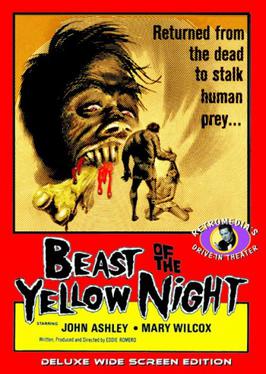
Beast of the Yellow Night is a 1971 Filipino/American horror film, directed by Eddie Romero and starring John Ashley, who co-produced the film with Romero. It was the fourth release for Roger Corman's distribution company New World Pictures.

Ganito Kami Noon... Paano Kayo Ngayon? is a 1976 Philippine period drama film set in the end of Spanish colonization and the start of American colonization in the Philippines. Directed by Eddie Romero and written by Romero and Roy C. Iglesias, it stars Christopher de Leon and Gloria Diaz in the lead roles. The film was selected as the Philippine entry for the Best Foreign Language Film at the 49th Academy Awards, but was not accepted as a nominee.
Vaudeville in the Philippines, more commonly referred to as bodabil, was a popular genre of entertainment in the Philippines from the 1910s until the mid-1960s. For decades, it competed with film, radio and television as the dominant form of Filipino mass entertainment. It peaked in popularity during the Japanese occupation in the Philippines from 1941 to 1945. Many of the leading figures of Philippine film in the 20th century, such as Dolphy, Nora Aunor, Leopoldo Salcedo and Rogelio de la Rosa, began their showbusiness careers in bodabil.

Leopoldo Ganal Salcedo Sr. was a Filipino film actor dubbed as "The Great Profile" who specialized in portraying dramatic heroes.

Anita Linda, was a Filipino actress whose career spanned nearly eight decades and had done close to 400 motion pictures. A romantic lead in her early years, she gained widespread acclaim for her portrayals of maternal, elderly roles depicting Filipino struggles and their lifestyle. Often described as the face of Philippine cinema, she was one of the top box-office draws for two decades and has received numerous accolades from international film festivals & domestic award-giving bodies.

Sakay is a 1993 Filipino historical drama film directed by Raymond Red. The film stars Julio Diaz, Tetchie Agbayani, and Leopoldo Salcedo. It was produced by Alpha Omega Productions. The film portrays the latter part of the life of Filipino patriot and hero Macario Sakay, who was declared an outlaw and a criminal for continuing hostilities against the United States after the "official" end of the Philippine–American War. It was also the last movie appearance of Leopoldo Salcedo in 1993 5 years before his sudden death in 1998.

During the Japanese occupation of the islands in World War II, there was an extensive Philippine resistance movement, which opposed the Japanese and their collaborators with active underground and guerrilla activity that increased over the years. Fighting the guerrillas – apart from the Japanese regular forces – were a Japanese-formed Bureau of Constabulary, the Kenpeitai, and the Makapili. Postwar studies estimate that around 260,000 people were organized under guerrilla groups and that members of anti-Japanese underground organizations were more numerous. Such was their effectiveness that by the end of World War II, Japan controlled only twelve of the forty-eight provinces.

Only the Brave Know Hell is a 1965 Filipino-American war drama film directed by Eddie Romero and co-written by Romero and Cesar Amigo, starring John Saxon, Fernando Poe Jr. and Vic Diaz. It was produced by Hemisphere Pictures, which consisted of Eddie Romero, Kane W. Lynn and Irwin Pizor. In the Philippines, the Pilipino-language version was entitled Hanggang May Kalaban while the English-dubbed version was entitled Only the Brave Know Hell, both of which were released in February 1965, while in the United States, it was released as The Ravagers in December 1965.
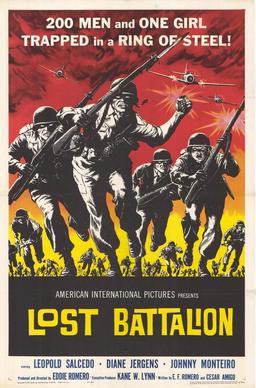
Lost Battalion is a 1960 black-and-white Filipino romantic war film produced and directed by Eddie Romero, and co-produced by Romero and Kane W. Lynn. Set during World War II, it stars Leopoldo Salcedo, Johnny Monteiro and Diane Jergens. It was later released in the US by American International Pictures as Lost Battalion, on a double feature with Guns of the Black Witch in 1962. The film's ad line read "200 Men and One Girl Trapped in a Ring of Steel!"

Wings of the Hawk is a 1953 3-D American Western film directed by Budd Boetticher and starring Van Heflin and Julie Adams. It is set during the Mexican Revolution.

The Walls of Hell, also known as Intramuros is a 1964 Philippine-American film directed by Eddie Romero and Gerardo de Leon and starring Jock Mahoney. The film was made back-to-back with Moro Witch Doctor (1964). It was produced by Hemisphere Pictures.
The Raiders of Leyte Gulf is a 1963 Philippine–American War film directed by Eddie Romero. It was the first film produced by the newly formed Hemisphere Pictures, a three-way partnership involving Filipino director Eddie Romero, American producers Kane W. Lynn and Irwin Pizor. It was written by Eddie Romero and Carl Kuntze


















